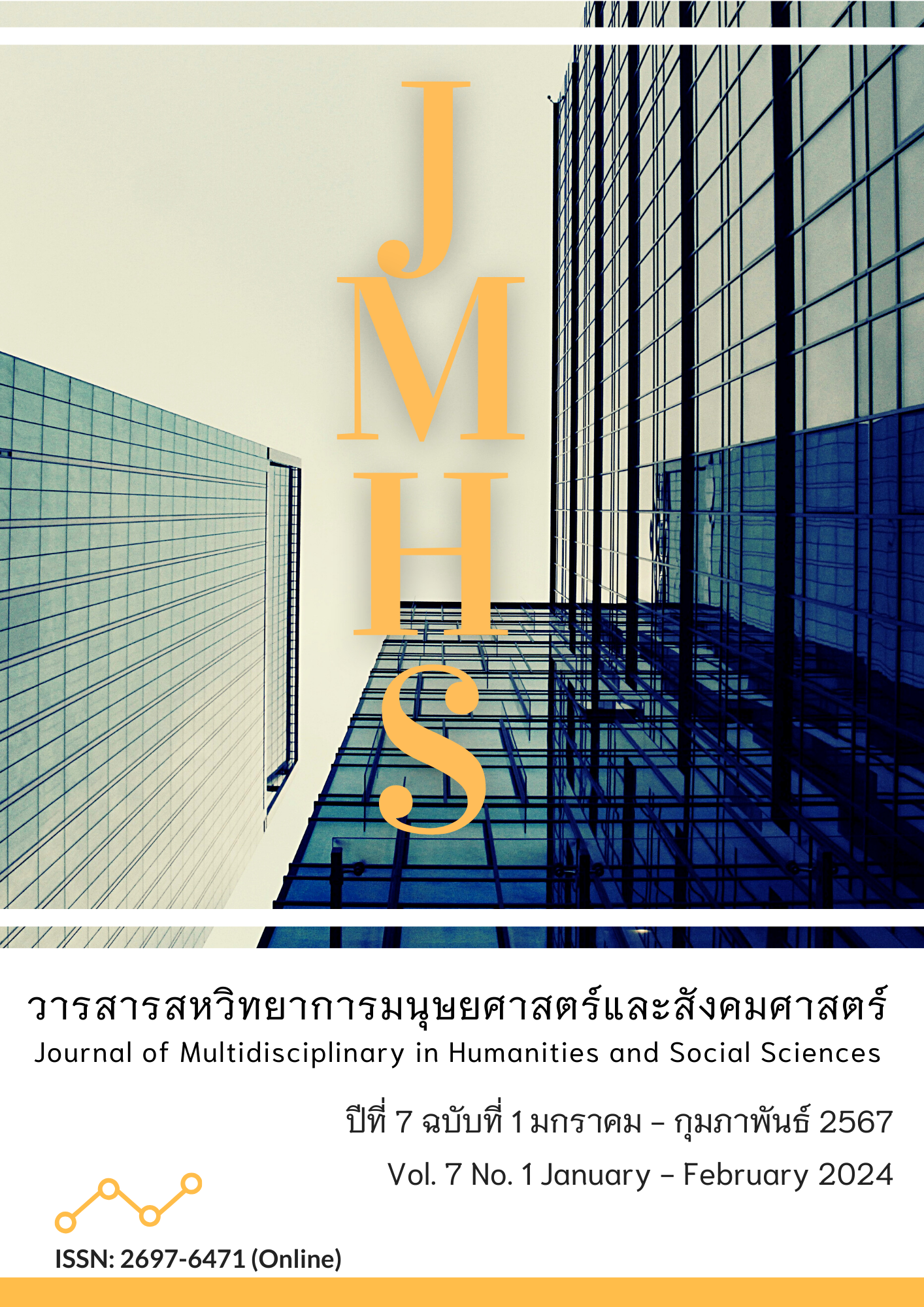Management of Remote Working in Crisis Situation that Impacts Employees' Productivity
Main Article Content
Abstract
This article aims to 1) study the influence of remote working factors, self-leadership, employee satisfaction, and work-related stress on the productivity of employees in private companies during the crisis situation in Thailand; and 2) develop a framework for managing remote working patterns among employees under the influence of remote working, employee satisfaction, self-leadership, work-related stress, and productivity. The research methodology employed a mixed-methods approach and utilized the job demand-resources model (JD-R model). The sample groups consisted of employees in private companies capable of remote work during the crisis period in Thailand. The sample was divided into two groups: Group 1, operational-level employees (n = 320), selected through convenient online questionnaire distribution, and Group 2, managerial-level employees (n = 8), selected through purposive sampling for in-depth interviews. The data was analyzed using descriptive statistics, path analysis, and content analysis of interviews.
The research findings indicated that self-leadership and employee satisfaction directly influence employee productivity. Specifically, self-leadership and remote work have indirect effects on productivity through employee satisfaction. The model fit indices support the relationship patterns (Chi-square = 143.08, df = 77, Chi-square/df = 1.86, GFI = 0.94, AGFI = 0.91, CFI = 0.97, and RMSEA = 0.06). Self-leadership exerts the strongest direct influence on productivity (0.77), followed by employee satisfaction (0.70), remote work (0.48), and work-related stress (-0.30). These factors collectively predict 67% of the productivity variance. The interviews revealed that remote work is suitable for employees with self-leadership qualities, clear work goals, and a sense of responsibility without the need for constant supervision. Additionally, organizations should provide appropriate tools and technology for remote work to enhance employee satisfaction and productivity.
The insights from this research can serve as valuable information for organizational decision-making, policy formulation, strategic enhancement, and process development. They help managers and stakeholders understand the factors influencing employee productivity in remote work settings, aiding future transitions to remote work formats.
Article Details

This work is licensed under a Creative Commons Attribution-NonCommercial-NoDerivatives 4.0 International License.
Views and opinions appearing in the Journal it is the responsibility of the author of the article, and does not constitute the view and responsibility of the editorial team.
References
ราชกิจจานุเบกษา. (2563). ข้อกำหนดออกตามความในมาตรา 9 แห่งพระราชกำหนดการบริหารราชการในสถานการณ์ฉุกเฉิน พ.ศ. 2548 (ฉบับที่ 1). เล่มที่ 137 ตอนพิเศษ 69 ง หน้า 10 (25 มีนาคม 2563).
Bakker, A. B., & Demerouti, E. (2017). Job demands–resources theory: Taking stock and looking forward. Journal of Occupational Health Psychology, 22(3), 273–285. https://doi.org/10.1037/ocp0000056
Beauregard, T. A., Basile, K. A., & Canonico, E. (2019). Telework. The Cambridge Handbook of Technology and Employee Behavior, 511–543. https://doi.org/10.1017/9781108649636.020
Cascio, W. (2000). Managing a virtual workplace. Academy of Management Perspectives, 14(3), 81-90. https://doi.org/10.5465/ame.2000.4468068
Contreras, F., Baykal, E., & Abid, G. (2020). E-leadership and teleworking in times of COVID-19 and beyond : What we know and where do we go. Frontiers in Psychology, 11. https://doi.org/10.3389/fpsyg.2020.590271.
CSSE. JHU. (2021). COVID-19 dashboard by the Center for Systems Science and Engineering (CSSE) at Johns Hopkins University (JHU). Retrieved January 21, 2021, from https://coronavirus.jhu.edu/map.html.
Gajendran, R. S., & Harrison, D. A. (2007). The good, the bad, and the unknown about telecommuting: Meta-analysis of psychological mediators and individual consequences. Journal of Applied Psychology, 92(6), 1524-1541. https://doi.org/10.1037/0021-9010.92.6.1524
Galanti, T., Guidetti, G., Mazzei, E., Zappalà, S. & Toscano, F. (2021). Work From Home during the COVID-19 outbreak. Journal of Occupational & Environmental Medicine, 63(7), e426-e432. https://doi.org/10.1097/JOM.0000000000002236
Grant, C. A., Wallace, L. M., & Spurgeon, P. C. (2013). An exploration of the psychological factors affecting remote e-worker's job effectiveness, well-being and work-life balance. Employee Relations, 35(5), 527-546. https://doi.org/10.1108/ER-08-2012-0059
Groysberg, B. (2020). How Remote Work Changes What we think about onboarding. Retrieved July 15, 2021, from https://hbswk.hbs.edu/item/how-remote-work-changes-what-we-think-about-onboarding
Hair J. F., Black W. C., Babin B. J., Anderson R. E. & Tatham R. L. (2006). Multivariate data analysis. (6th ed.). Pearson Prentice Hall: New Jersey.
Kaushik, N., & Arora, P. (2020). Performance appraisal in the era of new normal. Journal Of Technology Management for Growing Economies, 11(1), 11-15. https://doi.org/10.15415/jtmge.2020.111002
Kazekami, S. (2020). Mechanisms to improve labor productivity by performing telework. Telecommunications Policy, 44(2), 101868. https://doi.org/10.1016/j.telpol.2019.101868
Lavelle, J. (2020). Gartner CFO survey reveals 74% intend to shift some employees to remote work permanently. Retrieved July 15, 2021, from https://www.gartner.com/en/newsroom/press-releases/2020-04-03-gartner-cfo-survey-reveals-74-percent-of-orgs-to-shi ft-some-employees-to-remote-work-permanently
Ozimek, A. (2020). The future of remote work. SSRN Electronic Journal. https://doi.org/10.2139/ssrn.3638597
Petterson, S., Westfall, J., & Miller, B. (2020). Projected deaths of despair during the Coronavirus recession. Retrieved June 17, 2021, from https://wellbeingtrust.org/wp-content/uploads/2020/05/WBT_Deaths-of-Despair_COVID-19-FINAL-FINAL.pdf
Purwanto, A., Asbari, M., Fahlevi, M., Mufidt, A., Agistiawatis, E., Cahyonos, Y., & Suryani, P., (2020). Impact of Work From Home (WFH) on Indonesian teachers performance during the COVID-19 pandemic: An exploratory study. International Journal of Advanced Science and Technology, 29(5), 6235-6244. Retrieved from http://sersc.org/journals/index.php/IJAST/article/view/15627
Subramanyam, S. (2020). COVID-19: How are HRs handling and ensuring seamless work transitions. Retrieved April 6, 2021, from http://bwpeople.businessworld.in/article/COVID-19-How-Are-HRs-Handling-And-Ensuring-Seamless-Work-Transitions/01-04-2020-187881/.
Vega, R. P., Anderson, A. J., & Kaplan, S. A. (2015). A within-person examination of the effects of Telework. Journal of Business and Psychology, 30(2), 313-323. https://doi.org/10.1007/s10869-014-9359-4
Wang, B., Liu, Y., Qian, J., & Parker, S. (2020). Achieving effective remote working during the COVID-19 pandemic: A work design perspective. Applied Psychology, 70(1), 16-59. https://doi.org/10.1111/apps.12290.
WHO, (2020). Coronavirus prevention. Retrieved April 6, 2021, from https://www.who.int/health-topics/coronavirus#tab=tab_2c
Wood, B. A., Guimaraes, A. B., Holm, C. E., Hayes, S. W., & Brooks, K. R. (2020). Academic librarian burnout: A survey using the Copenhagen Burnout Inventory (CBI). Journal of Library Administration, 60(5), 512-531. https://doi.org/10.1080/01930826.2020.1729622
Xiao, Y., Becerik-Gerber, B., Lucas, G., & Roll, S.C. (2021). Impacts of working from home during COVID-19 pandemic on physical and mental well-being of office workstation users. Journal of Occupational and Environmental Medicine, 63(3), 181–190. https://doi.org/10.1097/JOM.0000000000002097


